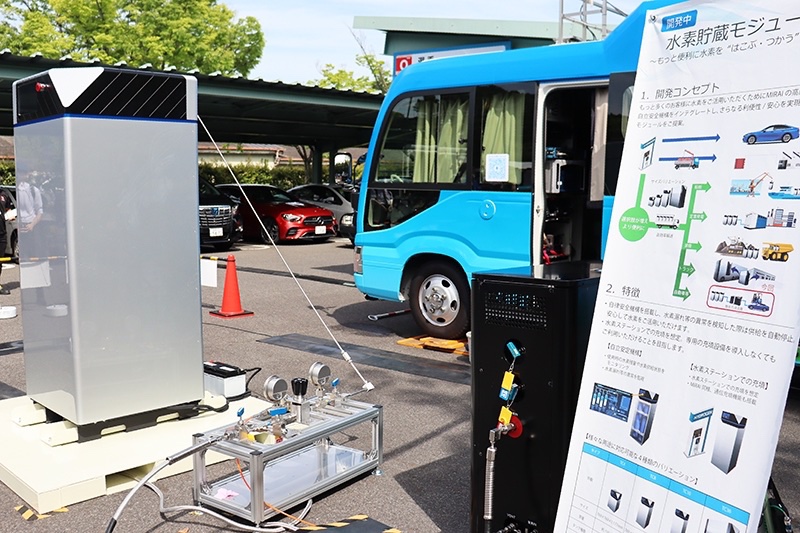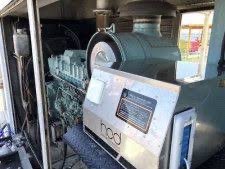

Toyota’s new hydrogen station: 5 times the loading capacity and 1/10 the cost!
-Overview of the new “hydrogen storage module”-
Toyota Motor:
In order to transport and use hydrogen safely and securely, we embarked on a demonstration of a “hydrogen storage module.”
Even if there is no hydrogen station nearby, it can be operated with high efficiency and low cost.
Rules for transporting and using hydrogen:
ーCurrently, there is no legal frameworkー
We have obtained special approval from the Ministry of Economy, Trade and Industry and the High Pressure Gas Association (KHK), and are proceeding with demonstration experiments.
Toyota’s “hydrogen storage module”:
In April of this year, hydrogen was transported to the Nagoya Golf Club and a demonstration test of the hydrogen storage module was conducted.
A “storage module with a hydrogen load capacity of about 10 kg” was installed at a golf course and charged into a fuel cell (FCV) of a television station.
Toyota Hydrogen Product Development Department:
ーInstallation location of the hydrogen storage moduleー
It is envisioned as a fuel source for working mobility, such as “ports and mountainous areas where there are no hydrogen stations nearby.”
Installation of hydrogen stations:
Currently, the installation of hydrogen stations is limited to urban areas.
In order to utilize hydrogen in rural areas, transportation is inevitable.
Challenges for hydrogen transport vessels:
Currently, there are metal tanks as transportation containers.
The problem with metal tanks was that they were heavy and had a low pressure response.
Use resin tanks:
Toyota has developed a plastic tank for its FCV “MIRAI.”
The hydrogen storage module is “combined with safety functions such as sensors and automatic shut-off valves.”
Hydrogen capacity:
-Four types available with a hydrogen loading capacity of 4kg to 36kg-
It also has a mechanism for direct refilling from a hydrogen station.
Abnormalities such as hydrogen leaks are monitored using a tablet terminal.
Features of resin tanks:
– 5.5 times more hydrogen than existing metal tanks –
The cost is reduced to 1/10 compared to “mobile hydrogen stations, which are mainly trailer-type.”
law
Special approval was obtained in September 2022, and transport became possible.
Evaluate both the delivery and use of hydrogen over a year and a half.
https://news.yahoo.co.jp/articles/3b2ed4626633bdce466938ac079ee47d0f534d7d
La nouvelle station hydrogène de Toyota : 5 fois la capacité de chargement et 1/10 du coût !
-Vue d’ensemble du nouveau “module de stockage d’hydrogène”-
Moteur Toyota :
Afin de transporter et d’utiliser l’hydrogène en toute sécurité, nous nous sommes lancés dans une démonstration d’un “module de stockage d’hydrogène”.
Même s’il n’y a pas de station d’hydrogène à proximité, elle peut être exploitée avec un rendement élevé et à faible coût.
Règles de transport et d’utilisation de l’hydrogène :
ーActuellement, il n’y a pas de cadre légalー
Nous avons obtenu l’approbation spéciale du ministère de l’Économie, du Commerce et de l’Industrie et de l’Association du gaz à haute pression (KHK) et procédons à des expériences de démonstration.
Le “module de stockage d’hydrogène” de Toyota :
En avril de cette année, l’hydrogène a été transporté au club de golf de Nagoya et un test de démonstration du module de stockage d’hydrogène a été effectué.
Un “module de stockage d’une capacité de charge d’hydrogène d’environ 10 kg” a été installé sur un terrain de golf et chargé dans une pile à combustible (FCV) d’une station de télévision.
Département de développement de produits Toyota Hydrogen :
ーEmplacement d’installation du module de stockage d’hydrogèneー
Il est envisagé comme une source de carburant pour la mobilité professionnelle, comme “les ports et les zones montagneuses où il n’y a pas de stations d’hydrogène à proximité”.
Installation de stations hydrogène :
Actuellement, l’installation de stations hydrogène est limitée aux zones urbaines.
Pour utiliser l’hydrogène dans les zones rurales, le transport est incontournable.
Enjeux pour les navires de transport à hydrogène :
Actuellement, il existe des réservoirs métalliques comme conteneurs de transport.
Le problème avec les réservoirs en métal était qu’ils étaient lourds et avaient une réponse à basse pression.
Utilisez des bacs à résine :
Toyota a développé un réservoir en plastique pour son FCV « MIRAI ».
Le module de stockage d’hydrogène est “associé à des fonctions de sécurité telles que des capteurs et des vannes d’arrêt automatiques”.
Capacité hydrogène :
-Quatre types disponibles avec une capacité de chargement d’hydrogène de 4kg à 36kg-
Il dispose également d’un mécanisme de remplissage direct à partir d’une station d’hydrogène.
Les anomalies telles que les fuites d’hydrogène sont surveillées à l’aide d’un terminal de tablette.
Caractéristiques des bacs à résine :
– 5,5 fois plus d’hydrogène que les réservoirs métalliques existants –
Le coût est réduit de 1/10 par rapport aux “stations hydrogène mobiles, qui sont principalement de type remorque”.
loi
Un agrément spécial a été obtenu en septembre 2022, et le transport est devenu possible.
Évaluer à la fois la livraison et l’utilisation de l’hydrogène sur un an et demi.
Toyotas neue Wasserstofftankstelle: 5-fache Ladekapazität und 1/10 der Kosten!
-Überblick über das neue „Wasserstoffspeichermodul“-
Toyota-Motor:
Um Wasserstoff sicher zu transportieren und zu nutzen, haben wir mit der Demonstration eines „Wasserstoffspeichermoduls“ begonnen.
Selbst wenn keine Wasserstofftankstelle in der Nähe ist, kann sie mit hoher Effizienz und geringen Kosten betrieben werden.
Regeln für den Transport und die Nutzung von Wasserstoff:
„Derzeit gibt es keinen rechtlichen Rahmen“.
Wir haben eine Sondergenehmigung des Ministeriums für Wirtschaft, Handel und Industrie und des Hochdruckgasverbandes (KHK) erhalten und führen Demonstrationsexperimente durch.
Toyotas „Wasserstoffspeichermodul“:
Im April dieses Jahres wurde Wasserstoff zum Nagoya Golf Club transportiert und ein Demonstrationstest des Wasserstoffspeichermoduls durchgeführt.
Auf einem Golfplatz wurde ein „Speichermodul mit einer Wasserstoff-Belastbarkeit von ca. 10 kg“ installiert und in eine Brennstoffzelle (FCV) eines Fernsehsenders geladen.
Entwicklungsabteilung für Wasserstoffprodukte von Toyota:
ーEinbauort des Wasserstoffspeichermodulsー
Es ist als Kraftstoffquelle für die Arbeitsmobilität vorgesehen, etwa in „Häfen und Berggebieten, in denen es keine Wasserstofftankstellen in der Nähe gibt“.
Installation von Wasserstoffstationen:
Derzeit ist die Installation von Wasserstofftankstellen auf städtische Gebiete beschränkt.
Um Wasserstoff in ländlichen Gebieten nutzen zu können, ist der Transport unumgänglich.
Herausforderungen für Wasserstofftransportschiffe:
Derzeit gibt es Metalltanks als Transportbehälter.
Das Problem bei Metalltanks bestand darin, dass sie schwer waren und nur auf einen niedrigen Druck reagierten.
Harztanks verwenden:
Toyota hat für sein FCV „MIRAI“ einen Kunststofftank entwickelt.
Das Wasserstoffspeichermodul sei „kombiniert mit Sicherheitsfunktionen wie Sensoren und automatischen Absperrventilen“.
Wasserstoffkapazität:
-Vier Typen verfügbar mit einer Wasserstoffladekapazität von 4kg bis 36kg-
Es verfügt außerdem über einen Mechanismus zum direkten Nachfüllen an einer Wasserstofftankstelle.
Auffälligkeiten wie Wasserstofflecks werden über ein Tablet-Terminal überwacht.
Merkmale von Harztanks:
– 5,5-mal mehr Wasserstoff als bestehende Metalltanks –
Die Kosten werden im Vergleich zu „mobilen Wasserstoffstationen, bei denen es sich hauptsächlich um Anhänger handelt“ auf ein Zehntel reduziert.
Gesetz
Im September 2022 wurde eine Sondergenehmigung erteilt und der Transport ermöglicht.
Bewerten Sie sowohl die Lieferung als auch die Nutzung von Wasserstoff über einen Zeitraum von anderthalb Jahren.